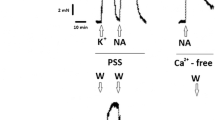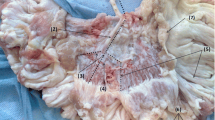Summary
The aim of the present study was to assess the different processes contributing to the contraction induced by noradrenaline (NA, 1 gmol/l) in the rat isolated aorta. Pretreatment with maximally effective concentrations of nifedipine or cromakalim reduced the NA-induced contraction to 80 ± 3.5% or 63 ± 2.0%, respectively, without alteration of the shape of the response. After pretreatment with Mn2+, NA caused a transient phasic contraction followed by a sustained tonic component, comparable to the response obtained in “Ca2+-free” medium. Ryanodine — in the presence of extracellular Ca2+ — caused a slight increase of resting tension, but did not modify the NA-induced contraction. In “Ca2+-free” medium the contraction elicited by NA consisted of a transient phasic and a sustained tonic component. The amplitude of the phasic contraction decreased exponentially with the time of exposure to “Ca2+-free” medium. The phasic component was identified as elicited by Ca2+ released from the sarcoplasmic reticulum (SR) by means of ryanodine. If Ca2+ depleted tissues (80 min in “Ca2+-free” solution) were exposed to Ca2+ in the presence of Mn2+ or cromakalim, the NA-induced phasic response was inhibited, suggesting that Mn2+ and cromakalim blocked the refilling of the store. It can be concluded that activation of α1-adrenoceptors in the rat aorta by NA elicits Ca2+-entry processes which have a different sensitivity to nifedipine, cromakalim and Mn2+. The Ca2+ released from SR contributes about 20% to the overall contractile response. Our data suggest that the depleted SR can be refilled from the extracellular space via a direct cromakalim- and Mn2+-sensitive pathway.
Similar content being viewed by others
References
Berridge MJ (1984) Inositol triphosphate and diacylglycerol as second messengers. Biochem J 220:345–360
Bray KM, Weston AH, McHarg AD, Newgreen DT, Southerton JS (1988) Comparison of the inhibitory effects of BRL 34915 and nifedipine on noradrenaline- and KCl-induced contractions in rabbit aorta. Br J Pharmacol 93:P59
Casteels R, Droogmans G (1981) Exchange characteristics of the noradrenaline-sensitive calcium store in vascular smooth muscle cells of rabbit ear artery. J Physiol 317:263–279
Cauvin C, Malik S (1984) Induction of Ca2+ influx and intracellular Ca2+ release in isolated rat aorta and mesenteric resistance vessels by norepinephrine activation of alpha-1 receptors. J Pharmacol Exp Ther 230:413–418
Cauvin C, Loutzenhiser R, Van Breemen C (1983) Mechanisms of calcium antagonist-induced vasodilation. Ann Rev Pharmacol Toxicol 23:373–396
Chiu AT, Mc Call DE, Thoolen MJMC, Timmermans PBMWM (1986) Calcium utilization in the constriction of rat aorta to full and partial alpha-1 adrenoceptor agonists. J Pharmacol Exp Ther 238:224–231
Chiu AT, Bozarth JM, Timmermans PBMWM (1987) Relationship between phosphatidylinositol turnover and calcium mobilization induced by α1-adrenoceptor stimulation in the rat aorta. J Pharmacol Exp Ther 240:123–127
Chiu PJS, Tetzloff G, Ahn H, Sybertz EJ (1988) Effects of BRL 34915 a putative K+ channel opener on transmembrane 45Ca movements in rabbit aortic smooth muscle. Eur J Pharmacol 155:229–237
Cook NS (1988) The pharmacology of potassium channels and their therapeutic potential. TIPS 9:21–28
Danthuluri NR, Deth RC (1984) Phorbol ester induced contraction of arterial smooth muscle and inhibition of α-adrenergic response. Biochem Biophys Res Commun 3:1103–1109
Deth RC, Lynch CJ (1981) Inhibition of α-receptor-induced Ca2+ release and Ca2+ influx by Mn2+ and La3+. Eur J Pharmacol 71:1–11
Devine CE, Somlyo AV, Somlyo AP (1972) Sarcoplasmic reticulum and excitation-contraction coupling in mammalian smooth muscle. J Cell Biol 52:690–718
Droogmans G, Himpens B, Casteels R (1985) Ca-exchange, Ca-channels and Ca-antagonists. Experientia 41:895–900
Fabiato A (1985) Effects of ryanodine in skinned cardiac cells. Fed Proc 44:2970–2976
Feher JJ, Lipford GB (1985) Calcium oxalate and calcium phosphate capacities of cardiac Sarcoplasmic reticulum. Biochem Biophys Acta 818:373–385
Fleischer S, Ogunbunmi EM, Dixon MC, Feher EAM (1985) Localization of Ca2+ release channels with ryanodine in junctional terminal cisternae of sarcoplasmic reticulum of fast skeletal muscle. Proc Natl Acad Sci USA 82:7256–7259
Furchgott RF, Zawadski JV (1980) The obligatory role of endothelial cells in the relaxation of arterial smooth muscle by acetylcholine. Nature 288:373–376
Godfraind T (1981) Mechanisms of action of calcium entry blockers. Fed Proc 40:2866–2871
Godfraind T, Miller R, Wibo M (1986) Calcium antagonism and calcium entry blockade. Pharmacol Rev 38:321–416
Haeusler G, de Peyer JE (1988) Electrical and mechanical effects of various agonists in vascular muscle of rabbit aorta. Naunyn-Schmiedeberg's Arch Pharmacol Suppl 337:R 289
Hallam TJ, Rink TJ (1989) Receptor-mediated Ca2+ entry: diversity of function and mechanism. Trends Pharmacol Sci 10:8–10
Heaslip RJ, Rahwan RG (1982) Evidence for the existence of two distinct pools of intracellular calcium in the rat aorta accessible to mobilization by norepinephrine. J Pharmacol Exp Ther 221:7–13
Hidaka H, Inagaki M, Kawamoto S, Sasaki Y (1984) Isoquinoline-sulfonamides, novel and potent inhibitors of cyclic nucleotide dependent protein kinase and protein kinase C. Biochemistry 23:5036–5041
Hwang KS, Van Breemen C (1987) Ryanodine modulation of 45Ca efflux and tension in rabbit aortic smooth muscle. Pflügers Arch 408:343–350
Ito K, Takakura S, Sato K, Sutko JL (1986) Ryanodine inhibits the release of Ca from intracellular stores in guinea-pig aortic smooth muscle. Circ Res 58:730–734
Jenden DJ, Fairhurst AS (1969) The pharmacology of ryanodine. Pharmacol Rev 21:1–25
Julou-Schaeffer G, Freslon JL (1988) Effects of ryanodine on tension development in rat aorta and mesenteric resistance vessels. Br J Pharmacol 95:605–613
Karaki H, Weiss GB (1988) Calcium release in smooth muscle. Life Sci 42:111–122
Karaki H, Kubota H, Urakawa N (1979) Mobilization of stored calcium for phasic contraction induced by norepinephrine in rabbit aorta. Eur J Pharmacol 56:237–245
Khalil RA, Van Breemen C (1988) Sustained contraction of vascular smooth muscle: Ca2+ influx or C-kinase activation? J Pharmacol Exp Ther 244:537–542
Kobayashi S, Kanaide H, Nakamura M (1986) Complete overlap of caffeine- and K+ depolarization-sensitive intracellular calcium storage site in cultured rat arterial smooth muscle cells. J Biol Chem 261:15709–15713
Lattanzio FA, Schlatterer RG, Nicar M, Campbell KP, Sutko JL (1987) The effects of ryanodine on passive calcium fluxes across sarcoplasmic reticulum membranes. J Biol Chem 262:2711–2718
Leijten PAA, Van Breemen C (1984) The effects of caffeine on the noradrenaline-sensitive calcium store in rabbit aorta. J Physiol 357:327–339
Maxwell LC, Herlihy JT, Riedel GL (1983) Effects of ascorbic acid and EDTA on vascular contraction-response to catecholamines. Microvasc Res 26:81–88
Meissner G (1986) Ryanodine activation and inhibition of the Ca2+ release channel of sarcoplasmic reticulum. J Biol Chem 261:6300–6306
Merritt JE, Rink TJ (1987) Regulation of cytosolic free calcium in fura-2-loaded rat parotid acinar cells. J Biol Chem 262:17362–17369
Minneman KP (1988) α1-adrenergic receptor subtypes, inositol phosphates, and sources of cell Ca2+. Pharmacol Rev 40:87–119
Nishizuka Y (1984) The role of protein kinase C in cell surface signal transduction and tumor promotion. Nature 308:693–698
Putney JW (1986) A model for receptor regulated calcium entry. Cell Calcium 7:1–12
Quast U (1988) Comparison of 86Rb+ and 12K+ effluxes stimulated by the K+ channel opener BRL 34915 in vascular smooth muscle. Br J Pharmacol 93:19P
Rasmussen H, Forder J, Kojima J, Scriabine A (1984) TPA-induced contraction of isolated rabbit vascular smooth muscle. Biochem Biophys Res Commun 2:776–784
Smith JS, Imagawa T, Ma J, Fill M, Campbell KP, Coronado R (1988) Purified ryanodine receptor from rabbit skeletal muscle is the calcium-release channel of sarcoplasmic reticulum. J Gen Physiol 92:1–26
Spedding M (1987) Interaction of phorbol esters with Ca2+ channels in smooth muscle. Br J Pharmacol 91:377–384
Sutko JL, Kenyon JL (1983) Ryanodine modification of cardiac muscle responses to potassium-free solution. Gen Physiol 82:385–404
Sutko JL, Ito K, Kenyon JL (1985) Ryanodine: a modifier of sarcoplasmic reticulum calcium release in striated muscle. Fed Proc 44:2984–2988
Timmermans PBMWM, Thoolen MJMC (1987) Ca2+ utilization in signal transformation of α1-adrenergic receptors. In: Ruffolo RR Jr (ed) The α1-adrenergic receptors. Humana, Clifton, NJ, pp 113–187
Author information
Authors and Affiliations
Additional information
Send offprint requests to: B. Wilffert at the above address
Rights and permissions
About this article
Cite this article
Koch, P., Wilffert, B., Wilhelm, D. et al. An approach to differentiate between noradrenaline-elicited contractile processes in the rat isolated aorta. Naunyn-Schmiedeberg's Arch Pharmacol 342, 454–461 (1990). https://doi.org/10.1007/BF00169464
Received:
Accepted:
Issue Date:
DOI: https://doi.org/10.1007/BF00169464




